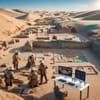Artificial intelligence teamed with Synthetic Aperture Radar (SAR) has uncovered traces of a Bronze‑Age society buried under the Rub’ al Khali, the “Empty Quarter” of Saudi Arabia. Researchers from Khalifa University fed satellite images into a machine‑learning model that can see through sand, identifying walls, pathways and settlement layouts that were invisible to the naked eye .
The discovered sites show sophisticated urban planning, well‑defined trade routes and structures built to withstand extreme desert conditions. These findings overturn earlier assumptions that the peninsula was sparsely inhabited 5,000 years ago, instead suggesting a network of thriving communities that linked the Indus Valley, Mesopotamia and the Levant .
SAR’s ability to map thousands of square kilometres in hours, combined with AI’s rapid pattern recognition, slashed the time and cost of traditional excavation. The technology also produces high‑resolution 3D models, giving archaeologists a detailed view of buried architecture without disturbing the ground .
Dubai’s Culture and Arts Authority has already approved targeted digs at Saruq Al‑Hadid, and scientists hope the same approach will illuminate hidden sites across North Africa, the Middle East and beyond, opening a new era of non‑invasive archaeology .


